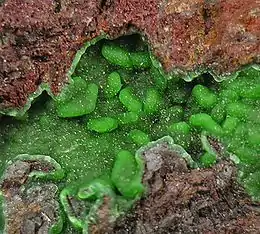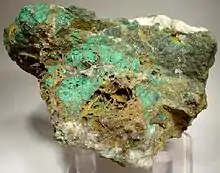Cornwallite
Cornwallite is an uncommon copper arsenate mineral with formula Cu5(AsO4)2(OH)4. It forms a series with the phosphate pseudomalachite and is a dimorph of the triclinic cornubite. It is a green monoclinic mineral which forms as radial to fibrous encrustations.
| Cornwallite | |
|---|---|
 Cornwallite in a vug from Pastrana, Murcia, Spain (size: 4.3 x 3.7 x 2.2 cm) | |
| General | |
| Category | Arsenate mineral |
| Formula (repeating unit) | Cu5(AsO4)2(OH)4 |
| Strunz classification | 8.BD.05 |
| Dana classification | 41.4.2.2 |
| Crystal system | Monoclinic |
| Crystal class | Prismatic (2/m) (same H-M symbol) |
| Space group | P21/c |
| Unit cell | a = 17.33 Å, b = 5.82 Å, c = 4.60 Å; β = 92.22°; Z = 2 |
| Identification | |
| Color | Verdigis green, blackish-green, emerald-green |
| Crystal habit | Microcrystalline radial fibrous, botryoidal to globular crusts |
| Cleavage | Distinct in one direction |
| Fracture | Conchoidal |
| Tenacity | Brittle |
| Mohs scale hardness | 4.5 |
| Luster | Sub-vitreous, resinous, waxy |
| Streak | Apple green |
| Diaphaneity | Translucent to opaque |
| Specific gravity | 4.17 |
| Optical properties | Biaxial (+/-) |
| Refractive index | nα = 1.810 - 1.820 nβ = 1.815 - 1.860 nγ = 1.850 - 1.880 |
| Birefringence | δ = 0.040 - 0.060 |
| 2V angle | Measured: 30° to 50° |
| References | [1][2][3][4] |
Discovery and occurrence
It was first described in 1846, for an occurrence in Wheal Gorland, St Day United Mines of the St Day District, Cornwall, England.[3] It occurs as secondary mineral in the oxidized zone of copper sulfide deposits. Associated minerals include olivenite, cornubite, arthurite, clinoclase, chalcophyllite, strashimirite, lavendulan, tyrolite, spangolite, austinite, conichalcite, brochantite, azurite and malachite.[2]
See also
Kernowite, another mineral named after Cornwall
References
This article is issued from Wikipedia. The text is licensed under Creative Commons - Attribution - Sharealike. Additional terms may apply for the media files.
